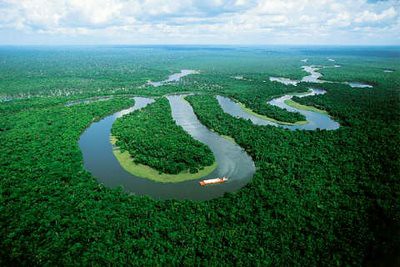
This is very good news (indeed!) but it is important to note that the deforestation statistics refer only to total clearing (clear-cutting) and do not include forest degradation from fire and selective logging. Recently, forest degradation has been surging and is an unreported but substantial source of carbon emissions.
[Note: The profound implications of forest degradation for an Amazonian die-back has been explored in the climate models of Malhi, et al.]
Recently, in part because landowners have been switching to logging smaller patches that are not defined or monitored as "deforestation" and because of other forms of back-country development (small roads and clearings), fire and forest degradation have reached the point where they contribute as much GHG emissions as outright deforestation. But, these emissions are not recorded in the official government tally of reduced deforestation.
Under the pressure of drought, selective logging, infrastructure development, small-scale fragmentation, etc, large areas of the Amazon are shifting from rainforests of timber to drier forests of tinder. It used to be that the many natural lightning strikes from scattered thunderstorms did NOT start fires because the forest was too wet. The same was true with the use of fire for small-scale clearing. But this is no longer true in a forest with a longer and more intense dry season.
It's important to remember that Amazonia has not always been covered with forests. They seem to be dependent on clear seasonal changes. Actually the delicate balance between wet and dry seasons seems to be disappearing and the fear is that much of forest will have longer dry seasons and tip the wet/dry balance toward a cerrado (savanna) climate. Both forest and cerrado have the same annual rainfall, but at different times and for different durations. This kind of climate shift has happened before in the history of Amazonia and is a possibility that has profound implications for the rainfall patterns across the entire Brazilian agricultural zone and for the global climate system.
Rhett A. Butler reports on other considerations surrounding the recent deforestation statistics at Mongabay, December 01, 2010:
Deforestation in the Brazilian Amazon fell to the lowest rate on record, putting Brazil well on track to meet its targets for reducing rainforest destruction.
Analysis of satellite imagery by Brazil’s National Institute for Space Research (INPE) shows that 6,450 square kilometers of rainforest were cleared in the Amazon in the 12 months ended July 31, 2010, a 14 percent drop from the year earlier period.
Speaking in Brasilia, outgoing President Luiz Inácio Lula da Silva said Brazil is meeting its pledge to reduce greenhouse gas emissions.
“We are fulfilling the commitment we have made in Brazil. We will fulfill it because it’s our obligation to do so.”
In 2009 Brazil passed a law committing the country to reducing greenhouse gas emissions 36-39 percent from a projected 2020 baseline. The bulk of the emissions reductions would come from cutting the the country's deforestation rate, which until very recently, were the world's highest. Indonesia now loses more rainforest on an annual basis than Brazil.
In October President Lula announced that Brazil's 80 percent deforestation reduction target for the Amazon would be met by 2016, four years ahead of schedule.
Brazil's Ministry of Environment attributes falling deforestation in the Amazon to the Plan for Amazon Deforestation Prevention and Control (PPCDAM), which includes near real-time monitoring of deforestation, increased law enforcement, "regularization" of land titles, and new sustainable development initiatives. The effort has been supported by state governments, civil society and the private sector. For example, municipalities with high deforestation have been "blacklisted", making it more difficult to receive government support until they implement better controls. Meanwhile major retailers, including Walmart-Brazil and Pao d'Azucar, with the help of environmental NGOs, have implemented traceability systems for beef from the Amazon and signed zero deforestation pacts with suppliers. Major soy producers also have agreed to a moratorium on new deforestation, while the government says a plan to expand palm oil production will mandate strong environmental standards for plantations. Brazil's progress in reducing deforestation has also been aided by macroeconomic trends, including a strengthening Brazilian real (currency), which makes agricultural products less attractive in overseas markets.
But while the trends are positive, concerns remain. BNDES, Brazil's national development bank, is allocating tens of billions of dollars a year to new Amazon infrastructure projects—including dams and roads—which could increase pressure on forests, both inside and outside Brazil. At the same time, a political movement led by farmers and ranchers is pushing to relax some of the environmental protections established over the past 15 years, including a revision to the forest code, which requires Amazon landowners to maintain 80 percent forest cover on their holdings.
The Brazilian Amazon is also feeling the effects of climate change. This year saw the worst drought on record, which helped spur a large increase in wildfires and a spike in forest degradation in recent months. Climate modelers say drought in the southern Amazon is likely to worsen as sea surface temperatures in the tropical Atlantic rise. Perversely, the western and northern parts of the Amazon may see an increase in rainfall due to climate shifts.
Some environmentalists are further worried that efforts to protect the Amazon rainforest are coming at the expense of the cerrado, the woody grassland where much of Brazil's agricultural expansion is occurring. Today the cerrado is disappearing at least twice as fast as the Amazon rainforest.






No comments:
Post a Comment